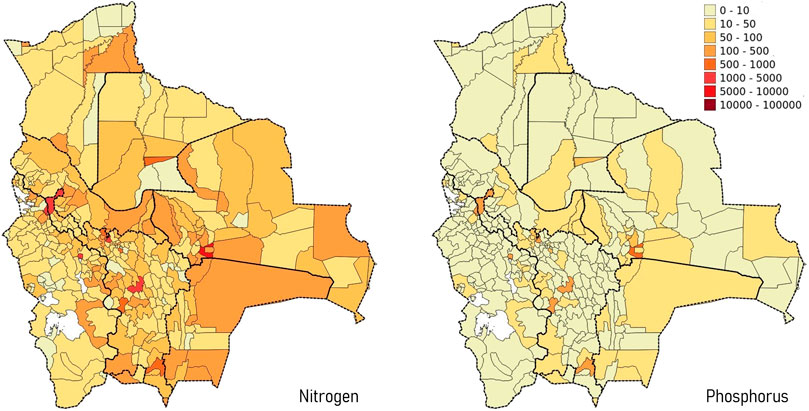
Availability of nutrients from human excreta in Bolivia in 2018.
In our latest article in #Frontiers in Environmental Sciences, Luis Fernando Perez Mercado, Cesar Ariel Perez Mercado, Bjorn Vinneras and Prithvi Simha analyse the current state of nutrient stocks, flows, and balances of the agri-food system in #bolivia. Their findings show that there is sufficient stock of #nitrogen and #phosphorus in human excreta to meet the deficit of nutrients in the food system, as well as regional nutrient surpluses that are not recirculated today. Today, Bolivia recirculates 44% of nitrogen and 74% of phosphorus used in agriculture. But we believe that circularity is going to decrease considerably over the coming years, as the national strategy to address nutrient deficits has been to increase the domestic production of synthetic fertilisers (See shorturl.at/abNQV).
Calculating mass balances always seems simple on paper. But it is difficult in practice, especially when you perform it at national, regional, and municipal levels, as we have done in this article. They usually don’t add up. Here, they also suggest how deforestation and depletion of forest nutrient stocks could be a reason why our national-level balance does not add up.
The full artile is available here: https://lnkd.in/d5dt42Qf
ABSTRACT: Analysis of the current state of nutrient stocks, flows, and balances of a territory is necessary to inform strategies that can transition the agri-food sector to a circular economy model. In this study, we quantified the nitrogen and phosphorus budgets for the Bolivian agri-food system at national and regional scales by way of agro-ecological zoning. We performed nutrient balances to calculate indicators for sufficiency (extent of nutrient deficit/surplus) and circularity (proportion of nutrients recirculated). We also evaluated the potential of renewable stocks (human excreta and livestock manure) to meet nutrient deficits in the system. Our results showed that there are apparent deficits of 32 kt N and 8 kt P in the system that cannot be accounted for using available data. We estimate the real deficits required to bring yields of 45 crops grown in Bolivia to parity with those of neighbouring countries to be 110 kt N and 33 kt P. About 44% of nitrogen and 74% of phosphorus is currently recirculated in the system, with the major nutrient inputs being biological nitrogen fixation, livestock manure, and crop residues. However, nutrient recycling is likely to decrease in the future because the national strategy to address nutrient deficits is to increase domestic production of synthetic fertilisers. Our analysis also shows that there is a sufficient stock of nutrients already available in human excreta (39 kt N and 5 kt P) to cover 100% of the nitrogen deficit and 64% of the phosphorus deficit. The low-altitude zone of Chiquitania-Pantanal alone accounts for 65% of cultivation and 80% of the nutrient demand in the country. Here, export-oriented crops like soybean and sorghum are grown, but less than 25% of the nitrogen is recirculated. In contrast, there are nutrient surpluses of 41 kt N and 34 kt P in agro-ecological zones like the Valleys and Altiplano where traditional agriculture is practiced, and the majority of food is grown for local consumption. Overall, we find that recycling of human excreta, combined with transfer of regional nutrient surpluses, could be an effective strategy to reduce the overall nutrient deficit in the system.
Froggi (Ramona) VanRiper, Cissy Amparo Lavadenz Vargas and Yan Xu peer-reviewed this article. Kangning Xu and shikun cheng edited the special issue in Frontiers in Environmental Science.
